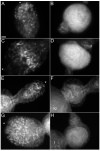Behavioral and spermatogenic hybrid male breakdown in Nasonia
- PMID: 20087395
- PMCID: PMC2872237
- DOI: 10.1038/hdy.2009.152
Behavioral and spermatogenic hybrid male breakdown in Nasonia
Abstract
Several reproductive barriers exist within the Nasonia species complex, including allopatry, premating behavioral isolation, postzygotic inviability and Wolbachia-induced cytoplasmic incompatibility. Here we show that hybrid males suffer two additional reproductive disadvantages, an inability to properly court females and decreased sperm production. Hybrid behavioral sterility, characterized by a reduced ability of hybrids to perform necessary courtship behaviors, occurs in hybrids between two species of Nasonia. Hybrid males produced in crosses between N. vitripennis and N. giraulti courted females at a reduced frequency (23-69%), compared with wild-type N. vitripennis and N. giraulti males (>93%). Reduced courtship frequency was not a simple function of inactivity among hybrids. A strong effect of cytoplasmic (mitochondrial) background was also found in N. vitripennis and N. giraulti crosses; F2 hybrids with giraulti cytoplasm showing reduced ability at most stages of courtship. Hybrids produced between a younger species pair, N. giraulti and N. longicornis, were behaviorally fertile. All males possessed motile sperm, but sperm production is greatly reduced in hybrids between the older species pair, N. vitripennis and N. giraulti. This effect on hybrid males, lowered sperm counts rather than nonfunctional sperm, is different from most described cases of hybrid male sterility, and may represent an earlier stage of hybrid sperm breakdown. The results add to previous studies of F2 hybrid inviability and behavioral sterility, and indicate that Wolbachia-induced hybrid incompatibility has arisen early in species divergence, relative to behavioral sterility and spermatogenic infertility.
Figures



Similar articles
-
Wolbachia-induced incompatibility precedes other hybrid incompatibilities in Nasonia.Nature. 2001 Feb 8;409(6821):707-10. doi: 10.1038/35055543. Nature. 2001. PMID: 11217858
-
Pheromone diversification and age-dependent behavioural plasticity decrease interspecific mating costs in Nasonia.PLoS One. 2014 Feb 14;9(2):e89214. doi: 10.1371/journal.pone.0089214. eCollection 2014. PLoS One. 2014. PMID: 24551238 Free PMC article.
-
Cytonuclear genic incompatibilities cause increased mortality in male F2 hybrids of Nasonia giraulti and N. vitripennis.Genetics. 2008 Jan;178(1):413-26. doi: 10.1534/genetics.107.080523. Genetics. 2008. PMID: 18202384 Free PMC article.
-
Effects of A and B Wolbachia and host genotype on interspecies cytoplasmic incompatibility in Nasonia.Genetics. 1998 Apr;148(4):1833-44. doi: 10.1093/genetics/148.4.1833. Genetics. 1998. PMID: 9560398 Free PMC article.
-
Sperm fate and function in reproductive isolation in Drosophila.Soc Reprod Fertil Suppl. 2007;65:155-73. Soc Reprod Fertil Suppl. 2007. PMID: 17644960 Review.
Cited by
-
Sex biased expression and co-expression networks in development, using the hymenopteran Nasonia vitripennis.PLoS Genet. 2020 Jan 27;16(1):e1008518. doi: 10.1371/journal.pgen.1008518. eCollection 2020 Jan. PLoS Genet. 2020. PMID: 31986136 Free PMC article.
-
Hybrid female mate choice as a species isolating mechanism: environment matters.J Evol Biol. 2016 Apr;29(4):865-9. doi: 10.1111/jeb.12818. Epub 2016 Jan 20. J Evol Biol. 2016. PMID: 26717048 Free PMC article.
-
Hybrid incompatibilities are affected by dominance and dosage in the haplodiploid wasp Nasonia.Front Genet. 2015 Apr 15;6:140. doi: 10.3389/fgene.2015.00140. eCollection 2015. Front Genet. 2015. PMID: 25926847 Free PMC article.
-
Reproductive isolation due to prezygotic isolation and postzygotic cytoplasmic incompatibility in parasitoid wasps.Ecol Evol. 2019 Aug 20;9(18):10694-10706. doi: 10.1002/ece3.5588. eCollection 2019 Sep. Ecol Evol. 2019. PMID: 31632650 Free PMC article.
-
Insect Innate Immunity Database (IIID): an annotation tool for identifying immune genes in insect genomes.PLoS One. 2012;7(9):e45125. doi: 10.1371/journal.pone.0045125. Epub 2012 Sep 12. PLoS One. 2012. PMID: 22984621 Free PMC article.
References
-
- Arnold ML. Natural Hybridization and Evolution. Oxford University Press; New York: 1997.
-
- Beukeboom L, van den Assem J. Courtship displays of introgressed, interspecific nasonia males: Further investigations into the ‘grandfather effect.’. Behaviour. 2002;139:1029–1042.
-
- Beukeboom LW, van den Assem J. Courtship and mating behaviour of interspecific Nasonia hybrids (Hymenoptera, Pteromalidae): a grandfather effect. Behav Genet. 2001;31(2):167–177. - PubMed
-
- Boake CRB. Sexual signaling and speciation, a microevolutionary perspective. Genetica. 2002;116:205–214. - PubMed
Publication types
MeSH terms
Grants and funding
LinkOut - more resources
Full Text Sources
Miscellaneous

